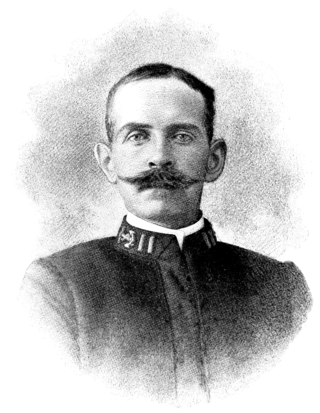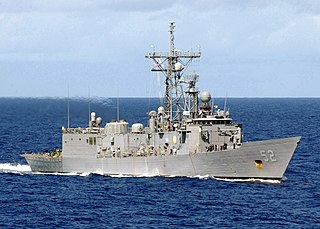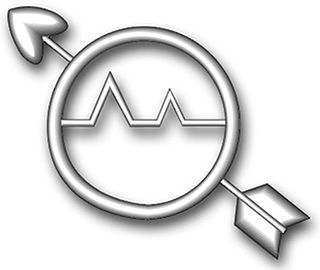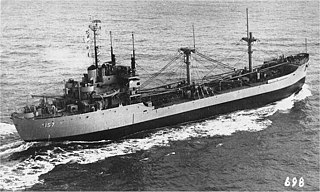Ship commissioning is the act or ceremony of placing a ship in active service and may be regarded as a particular application of the general concepts and practices of project commissioning. The term is most commonly applied to placing a warship in active duty with its country's military forces. The ceremonies involved are often rooted in centuries-old naval tradition.

The surface warfare insignia is a military badge of the United States Navy which is issued to U.S. Navy personnel who are trained and qualified to perform duties aboard United States surface warships. There are presently four classes of the surface warfare pin, being that of line, staff, special operations, and enlisted. The line and enlisted surface warfare badges may be earned by United States Coast Guard personnel assigned to Navy commands. The various badge types are as follows:

John Baptiste Bernadou was an officer in the United States Navy during the Spanish–American War. Born in Philadelphia, Bernadou graduated from the Naval Academy in 1880. He was promoted ten numbers for gallantry in action while commanding USS Winslow at the First and Second Battle of Cardenas, Cuba, from May 8 to May 11, 1898. John Baptiste Bernadou died at the Naval Hospital in Brooklyn, New York, on October 2, 1908, and is buried with his wife Florence Whiting in Arlington National Cemetery Section S. Div Site 2004 W.S

A bridge, or wheelhouse, is a room or platform of a ship, submarine, airship, or spaceship from which the ship can be commanded. When a ship is under way, the bridge is manned by an officer of the watch aided usually by an able seaman acting as a lookout. During critical maneuvers the captain will be on the bridge, often supported by an officer of the watch, an able seaman on the wheel and sometimes a pilot, if required.

USS Carr (FFG-52), was an Oliver Hazard Perry-class frigate of the United States Navy.

A chief mate (C/M) or chief officer, usually also synonymous with the first mate or first officer, is a licensed mariner and head of the deck department of a merchant ship. The chief mate is customarily a watchstander and is in charge of the ship's cargo and deck crew. The actual title used will vary by ship's employment, by type of ship, by nationality, and by trade: for instance, chief mate is not usually used in the Commonwealth, although chief officer and first mate are; on passenger ships, the first officer may be a separate position from that of the chief officer that is junior to the latter.
A second mate or second officer (2/O) is a licensed member of the deck department of a merchant ship holding a Second Mates Certificate of Competence, by an authorised governing state of the International Maritime Organization (IMO). The second mate is the third in command and a watchkeeping officer, customarily the ship's navigator. Other duties vary, but the second mate is often the medical officer and in charge of maintaining distress signaling equipment. On oil tankers, the second mate usually assists the chief mate with the cargo operations.

A third mate (3/M) or third officer is a licensed member of the deck department of a merchant ship. The third mate is a watchstander and customarily the ship's safety officer and fourth-in-command. The position is junior to a second mate. Other duties vary depending on the type of ship, its crewing, and other factors.

Watchkeeping or watchstanding is the assignment of sailors to specific roles on a ship to operate it continuously. These assignments, also known at sea as watches, are constantly active as they are considered essential to the safe operation of the vessel and also allow the ship to respond to emergencies and other situations quickly. These watches are divided into work periods to ensure that the roles are always occupied at all times, while those members of the crew who are assigned to work during a watch are known as watchkeepers.

A helmsman or helm is a person who steers a ship, sailboat, submarine, other type of maritime vessel, airship, or spacecraft. The rank and seniority of the helmsman may vary: on small vessels such as fishing vessels and yachts, the functions of the helmsman are combined with that of the skipper; on larger vessels, there is a separate officer of the watch who is responsible for the safe navigation of the ship and gives orders to the helmsman, who physically steers the ship in accordance with those orders.

The deck department is an organisational team on board naval and merchant ships. Seafarers in the deck department work a variety of jobs on a ship or vessel, but primarily they will carry out the navigation of a vessel from the bridge. However, they are usually also responsible for supervising and monitoring any maritime cargo on board, as well as ensuring maintenance of the deck and upper hull structure, monitoring the stability of the ship, including loading and discharging ballast water, carrying out mooring operations, and finally anchoring a ship.
An officer of the deck (OOD) underway is a watchstanding duty officer on a surface ship in the United States Navy, United States Coast Guard, and NOAA Commissioned Officer Corps who is tasked with certain duties and responsibilities for the ship. The officer of the deck is either subordinate to the command duty officer or, in the absence of one, reports directly to the ship's commanding officer and executive officer, in the latter case holding responsibility for the ship altogether. This article describes duties and responsibilities for an underway OOD for surface ships only.
Seafaring is a tradition that encompasses a variety of professions and ranks. Each of these roles carries unique responsibilities that are integral to the successful operation of a seafaring vessel. A ship's crew can generally be divided into four main categories: the deck department, the engineering department, the steward's department, and other. The reasoning behind this is that a ship's bridge, filled with sophisticated navigational equipment, requires skills differing from those used on deck operations – such as berthing, cargo and/or military devices – which in turn requires skills different from those used in a ship's engine room and propulsion, and so on.

A sea captain, ship's captain, captain, master, or shipmaster, is a high-grade licensed mariner who holds ultimate command and responsibility of a merchant vessel. The captain is responsible for the safe and efficient operation of the ship, including its seaworthiness, safety and security, cargo operations, navigation, crew management, and legal compliance, and for the persons and cargo on board.

Operations Specialist is a United States Navy and United States Coast Guard occupational rating. It is a sea duty-intensive rating in the Navy while most of Coast Guard OS's are at ashore Command Centers.

USS Alcona (AK-157) was an Alamosa-class cargo ship commissioned by the U.S. Navy for service in World War II. She was responsible for delivering troops, goods and equipment to locations in the war zone.

The United States Navy occupational rating of boatswain's mate is a designation given by the Bureau of Naval Personnel (BUPERS) to enlisted members who were rated or "striking" for the rating as a deck seaman. The colloquial form of address for a boatswain's mate is "Boats".

The 2009 USS Port Royal grounding was a ship grounding by the United States Navy guided missile cruiser Port Royal off Oahu, Hawaii on 5 February 2009. The ship ran aground on a coral reef, damaging both the ship and the reef. The incident received wide press coverage in Hawaii, in part because of the damage caused to a sensitive coral environment, and also because the stranded ship was within sight of Honolulu off the airport.
A principal warfare officer (PWO), is one of a number of warfare branch specialist officers.
Nautical operations refers to the crew operation of a ship. It is the term used in academic education to refer to the studies of this professional field. Nautical operations refers to all the operational procedures, specific roles of officers and crew members, and regular functions and technical processes, which together shape the structure and functions for the general operations of a ship.













